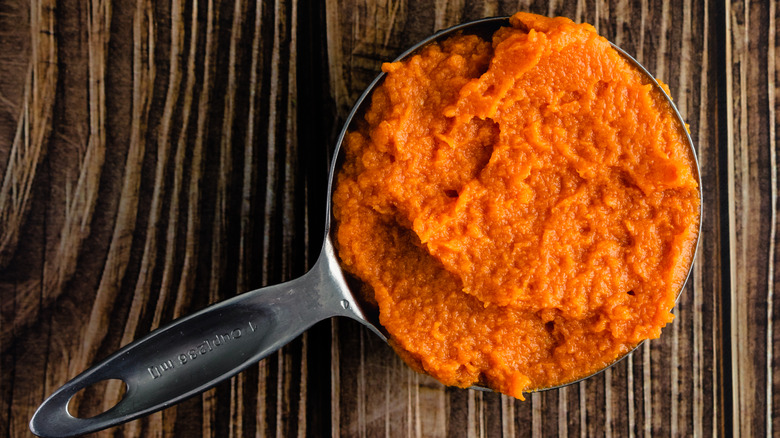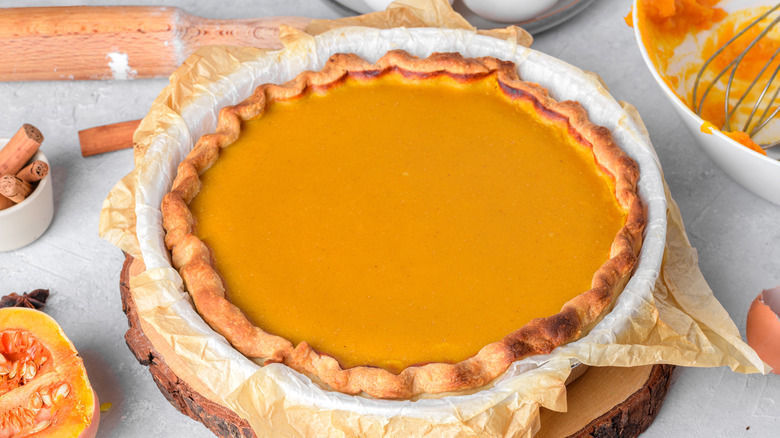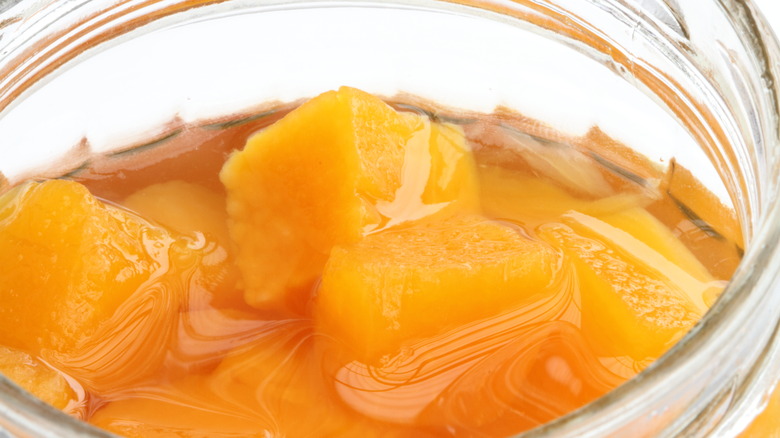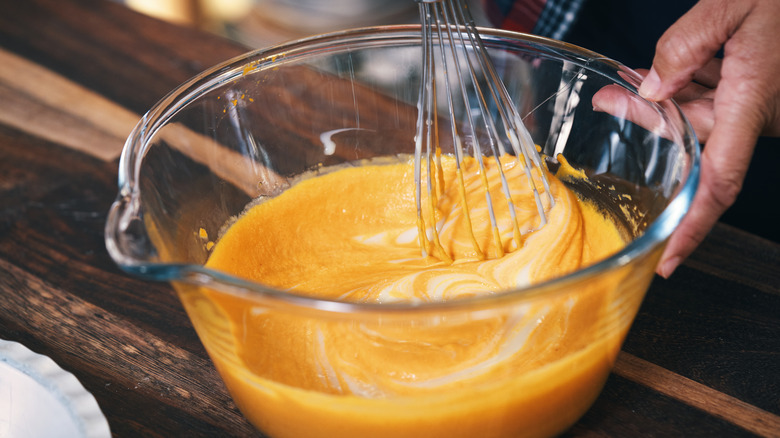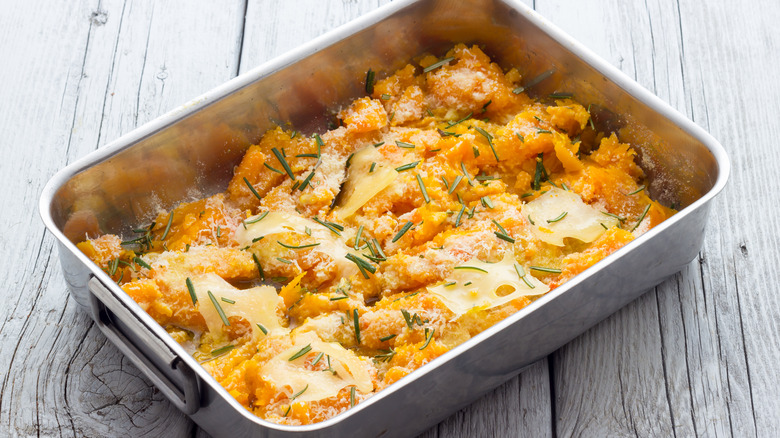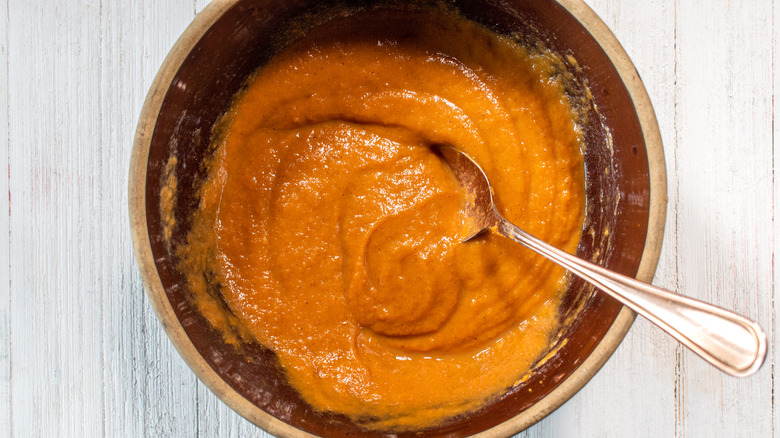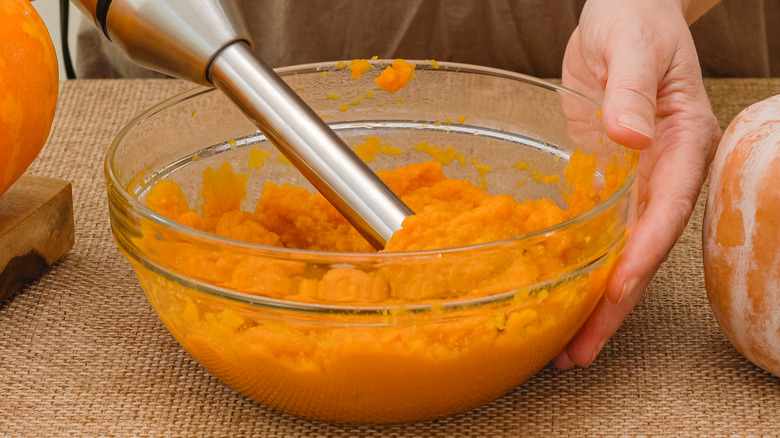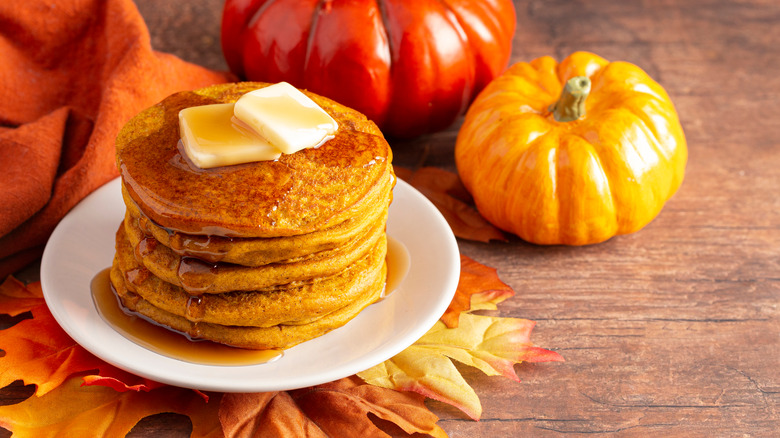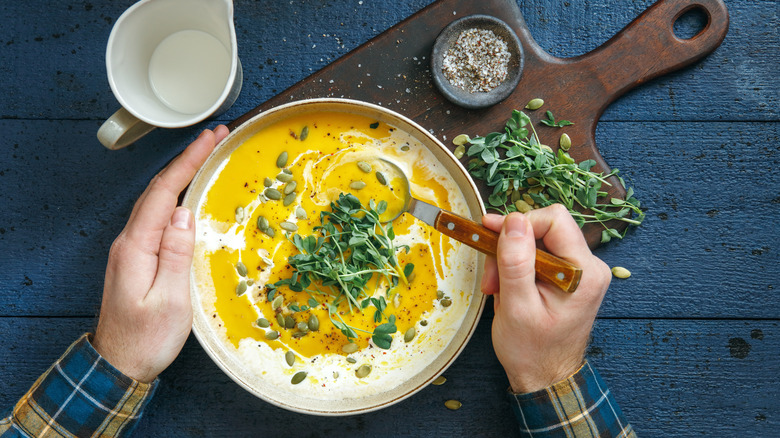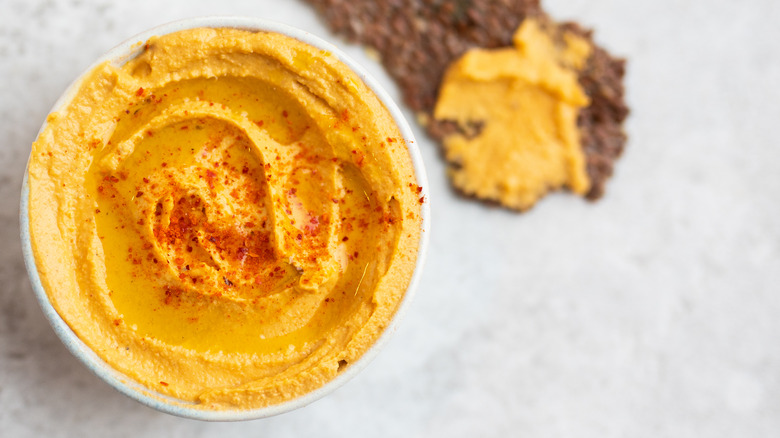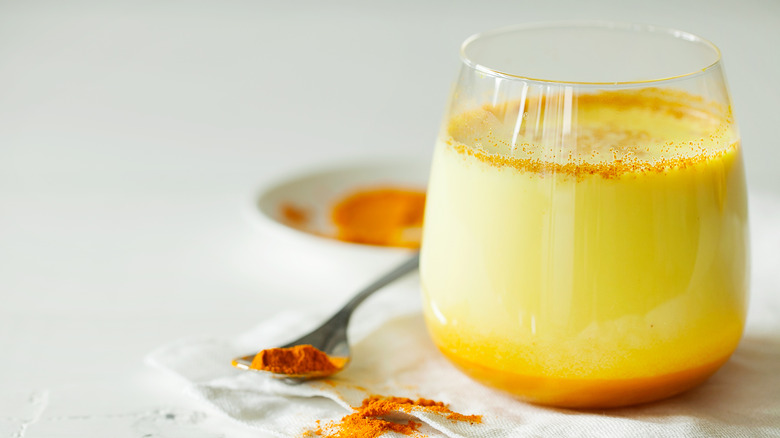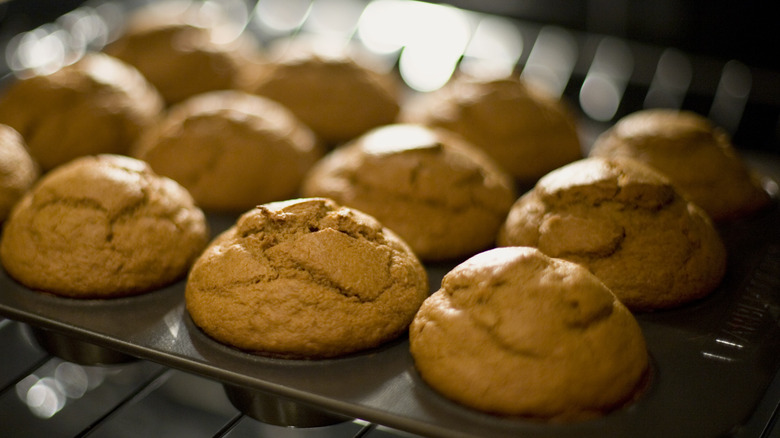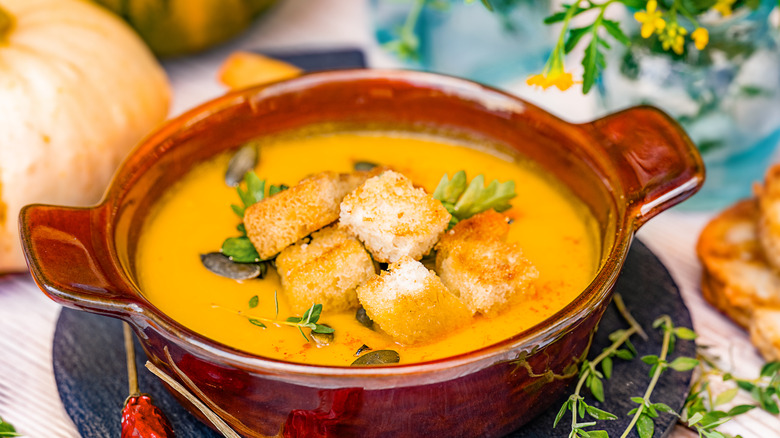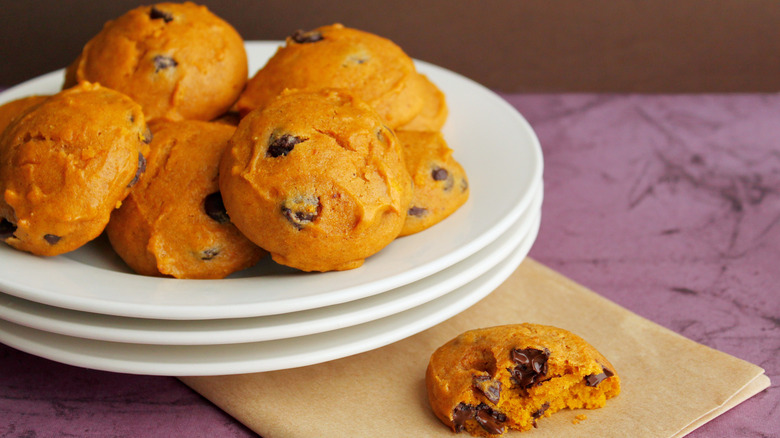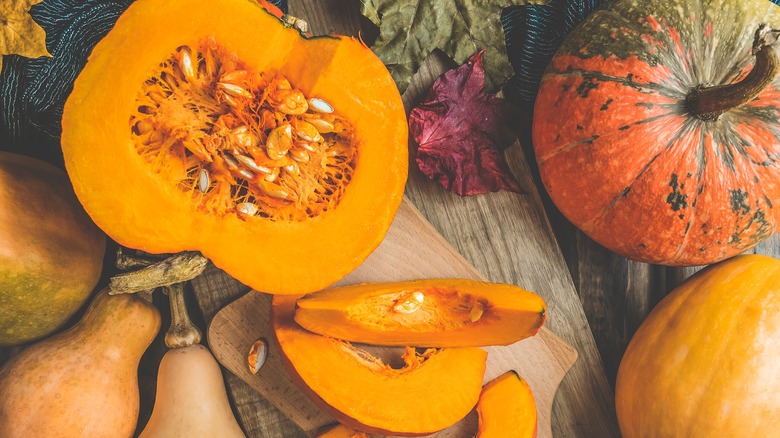Mistakes You Didn't Realize You Were Making With Canned Pumpkin
Canned pumpkin is an incredible cooking ingredient that doesn't always get the love it deserves. It's packed with flavor, low in calories, and it's also one of the most nutritious veggies around, with nutrients like vitamins A, B1, B6, and C, plus copper, fiber, folate, and manganese — all of which should make it very popular.
So what's the problem with canned pumpkin — why doesn't it end up on more plates or in more recipes? The sad fact is that despite all the reasons we should be eating it, canned pumpkin can be a tricky ingredient to use. Sure, we know it's good for pies but many people don't know what else to do with it. It also has some quirks that can make using it tricky, especially if you aren't that familiar or haven't cooked with it much before. In other words, cooking with canned pumpkin can bring about a lot of mistakes and errors — things you might not have even realized you were doing!
Fortunately, we're here to help. Read on to uncover the 14 most common mistakes chefs and home cooks alike make with canned pumpkin, so you can start piling this wonder food on your plate — and using it in all your favorite recipes — with abandon.
1. Confusing canned pumpkin with pumpkin pie filling
One of the most common mistakes people of all cooking experience levels make is assuming canned pumpkin and pumpkin pie filling are one and the same. It's an easy thing to do; both cans tend to be found right next to each other at the supermarket and the labels aren't always as clear as they should be. The next time you find yourself making the choice between the two, there are a few facts to keep in mind. Canned pumpkin typically only contains a single ingredient: pumpkin. It's thick and smooth and is essentially just cooked, pureed pumpkin that can be used in any number of different dishes.
Pumpkin pie filling (or mix) is a pre-made mixture that consists of pumpkin plus sweeteners and spices. Commonly added ingredients include sugar, spices (such as cinnamon, nutmeg, and cloves), and sometimes eggs or evaporated milk. Pumpkin pie filling is even smoother and creamier because of the extra ingredients, but it also has fewer uses and is less versatile. It can be used in pies, of course, plus some desserts and baked goods, but that's about it. To keep it simple, we suggest only ever buying canned pumpkin. If you're making a pie, just use it to create your own DIY filling from scratch!
2. Not draining excess liquid from the can before use
Whether you're buying canned pumpkin puree, canned pumpkin cubes, or perhaps even enjoying homemade canned pumpkin prepared by a friend or relative, it's important to remember that canned pumpkin should always be drained before use. Food scientists estimate that pumpkins contain up to 90% water. And even though some of this water is lost during the cooking and canning process, it doesn't all go away.
Depending on the brand of pumpkin you are buying and the way it was canned and processed, you can find anywhere from a small to a rather significant amount of water lurking in the bottom of the can when you open it. Temperature fluctuations and the conditions you've stored the can might also cause even more water to separate from the pumpkin before you have a chance to use it.
Whatever the reason for the excess water in your can, it's important to drain it before use. This ensures more consistency in your recipes when cooking, helps prevent sogginess (particularly in baked goods), and also helps to keep your recipes more accurate, ensuring better texture and flavor in your final product.
3. Forgetting to sweeten it
We've already mentioned that canned pumpkin and pumpkin pie filling can be easily confused. But it bears repeating that if you've purchased canned pumpkin and plan on using it in a dessert or anything else that is typically sweet to the taste, you will need to add some sort of sweetener to your recipe.
Pumpkin is a member of the squash family, just like acorn squash, spaghetti squash, and even zucchini and yellow squash. They're all related and grow in similar ways — and while some of them might have a subtle, natural sweetness on their own, it typically isn't enough to sweeten a dessert by itself. You need the addition of sugar, maple syrup, or whatever your recipe calls for to truly create that pumpkin goodness we all love.
If you're using pumpkin pie filling in a recipe in place of pumpkin, you might be able to skip the added sugar and modify the recipe as needed. But if you're using canned pumpkin, you definitely need to add a sweetener to those dessert recipes. If not, you risk those wonderful pies, muffins, or cakes being a savory dud.
4. Not using canned pumpkin in savory dishes
While dessert recipes featuring canned pumpkin definitely need an added sweetener, remember to never limit yourself in the ways you use canned pumpkin. It's a common mistake for people to think canned pumpkin is only meant for desserts or baked goods. But this delicious member of the squash family can also be used in an incredible number of savory dishes.
For example, you might combine cooked ziti pasta, canned pumpkin, cream, sage, garlic, and Parmesan cheese for an easy and incredibly satisfying weeknight-baked pasta dish. You can also layer lasagna noodles, ricotta cheese, canned pumpkin, and sauteed spinach for a delightful plant-based pumpkin lasagna. Canned pumpkin, black beans, corn, diced green chilies, tortillas, and taco seasoning combine beautifully for pumpkin enchiladas. Try canned pumpkin, crumbled cooked sausage, ricotta cheese, and spices as a filling for pasta shells. Or go the curry route and make a savory sauce with canned pumpkin, coconut milk, red lentils, and curry spices.
5. Not properly balancing flavors
Ripe, orange pumpkins have a uniquely earthy and subtly sweet flavor of their own. But to make canned pumpkin truly shine, you have to be sure to balance that flavor with whatever else you're pairing it with. Not doing so can be another common mistake that leaves a dish tasting too sweet, too bland, or just off in a way that lacks complexity and cohesion.
Balancing the flavor of canned pumpkin with other ingredients involves considering qualities like sweetness, acidity, saltiness, and the level of spice in your recipe. When making a sweet dish, be sure to complement the natural sweetness of your canned pumpkin with added sugar, honey, maple syrup, or another sweetener, adjusting to your liking.
For a more savory dish, focus on including an element of acidity in your recipe to brighten the flavor of the canned pumpkin and cut through its richness. A touch of vinegar, lemon juice, or acidic ingredients like tomatoes are all good options that will help bring balance to a savory pumpkin dish.
Finally, don't forget extra seasonings. Spices complement the earthy flavor of pumpkin and add depth and complexity to any dish. Experiment with spices like cinnamon, nutmeg, cloves, cumin, or chili powder to enhance the flavor of the pumpkin and really make it shine.
6. Over-processing the canned pumpkin
When using canned pumpkin, it's important to remember that the pumpkin has already been cooked and whipped into a puree — so it shouldn't take a lot of additional processing on your part. Too much extra blending or mixing is another common mistake that can dramatically impact the taste of your final dish.
Overprocessing canned pumpkin can break down its naturally smooth and velvety texture, creating a result that is mushy and slushy. It can also cause the pumpkin to release more water, leaving dishes watery or preventing them from setting properly. Not to mention, it introduces more air into the puree, promoting oxidation and making the pumpkin seem less fresh.
To avoid overprocessing, only use your mixer or blender in short bursts when cooking with canned pumpkin instead of letting it run continuously. Use a lower speed setting or simply mix by hand. Finally, make sure you are regularly scraping down the sides of your bowl as you mix. This helps to promote even blending and will ensure your pumpkin dish has the most consistent texture possible.
7. Forgetting pumpkin can be added to pancakes or waffles
When it comes to delicious ways to start the day, pumpkin muffins are one incredible option. But there are also ways to use canned pumpkin in the morning that don't entail baking at all. Witness the wonder of the pumpkin pancake. To make this incredible treat, combine 1 cup of pancake mix with ½ cup of canned pumpkin puree. If you're a fan of fall flavors, add 1 teaspoon of pumpkin spice as well. Next, pour in ¾ cup of milk and stir until the ingredients are just combined — if you see a few lumps, that's okay.
To make your pancakes, heat a griddle or non-stick skillet over medium heat and lightly grease it with butter or cooking spray. Then, spoon ¼ cup of batter onto the hot surface. Cook the pancakes until bubbles form on one side, then flip and cook the other side until golden brown. Serve your pumpkin pancakes warm with a drizzle of maple syrup and a generous dollop of butter. Prefer waffles over pancakes? You can make the same batter then just ladle it into your waffle maker and cook as normal.
8. Pairing pumpkin with the wrong herbs
Whatever pumpkin inspired dish you might have on your menu, it's important to remember that while the earthy, slightly sweet flavor of pumpkin goes well with most herbs and spices, it shouldn't be paired with everything.
Warming spices like cinnamon, ginger, and nutmeg go beautifully with the unique taste of pumpkin and are a classic ingredient in pumpkin pies, pumpkin cookies, and more. They've even inspired the classic pumpkin spice flavor that has since become so beloved around the globe. In addition to those classic options, pumpkin goes wonderfully with sage, thyme, and rosemary. Cumin's warm and slightly smoky quality is another winner to use, as are robust flavors like coriander and marjoram.
But not everything works quite so well with the natural flavor of the squash. Mint can overpower pumpkin's subtle sweetness, and the potent flavor of basil often clashes and should be used with care. Tarragon and dill are two more options you should steer clear of in your pumpkin-starring dishes as they can overpower the delicate flavor of the fall favorite.
9. Ignoring pumpkin as an ingredient in dips
While including pumpkin as part of an entree or dessert might be a given, how often have you thought about including it in an appetizer? if you're not considering pumpkin in this capacity — specifically, as a dip — then this is yet another mistake you're making when it comes to the many ways canned pumpkin can be put to use on a menu.
For starters, transform traditional hummus with the addition of canned pumpkin. In a food processor, blend chickpeas, tahini, garlic, lemon juice, olive oil, and canned pumpkin until smooth. The pumpkin will help give the hummus an even more velvety texture and will also bring in a touch of sweetness and earthiness. Serve your pumpkin hummus with pita wedges, veggie sticks, or use it as a spread for sandwiches.
Did you know that pumpkin can be a vibrant addition to homemade or premade salsa? Simply stir a couple of tablespoons of canned pumpkin into your favorite recipe or bottle. It will add an unexpected creaminess plus a subtle sweetness, similar to what you might get with salsa made from peaches or mangoes. Pumpkin can also be incorporated into savory Greek yogurt dips, guacamole, and even queso. Just let your imagination — and taste buds — soar.
10. Not using it as an ingredient in delicious morning smoothies
With all of its available nutrients plus that uber satisfying creamy texture, canned pumpkin is a natural ingredient for morning smoothies and protein shakes. And if you're not using it in yours, that's another big mistake you need to fix now. For instance, you can throw together a delicious and nutritious wake-up smoothie in minutes using canned pumpkin, a ripe banana, Greek yogurt, milk, and a sprinkle of turmeric or pumpkin pie spice. Add your ingredients plus a handful of ice to a blender and process until smooth.
For a heartier pre-workout shake, try blending canned pumpkin with vanilla protein powder, almond butter, a splash of milk, and a dash of cinnamon. Or, for a twist on your favorite morning green smoothie, combine canned pumpkin with spinach, banana, coconut water, and a squeeze of fresh lime juice for a vibrant treat that's packed with freshness and all the nutrients you need to start the day.
11. Substituting it into baked goods in the wrong amounts
Canned pumpkin can be used in countless ways — you can even substitute it for other ingredients when baking. It can replace other veggie purees, applesauce, Greek yogurt, sour cream, and sometimes even butter or oil. But if you plan on substituting canned pumpkin for another ingredient in a recipe, make sure you do it carefully. Always measure accurately to maintain the proper balance of ingredients and ensure baked goods rise and bake as they are supposed to.
Also, be sure to keep an eye on moisture levels since canned pumpkin adds water to baked goods. If you're substituting it for a drier ingredient, like applesauce or mashed bananas, be mindful of its moisture content. You may even need to reduce the amount of other liquid ingredients in the recipe to make up for your substitution. Finally, remember that canned pumpkin has an incredibly smooth and velvety texture. You might need to adjust the ratios of other wet and dry ingredients in order to maintain the recipe's consistency.
To make your substitutions a success, use a 1-to-1 ratio by incorporating the same amount of canned pumpkin as whatever you are substituting. And if you're in doubt about how the recipe will turn out, only make a partial substitution. Use half of the original ingredient the recipe calls for and then swap the remaining half for canned pumpkin.
12. Neglecting to add it to chili or soups
Like savory casseroles, soups and stews are another wonderful way to use canned pumpkin. And if you aren't including these pumpkin-infused dishes on your fall and winter menus, you should be.
You can make a creamy pumpkin soup in just 15 minutes using basic ingredients like shallots, ginger, canned pumpkin, cannellini beans, coconut milk, vegetable broth, miso paste, and spices. To make a curried pumpkin lentil soup, simply saute diced onions, carrots, and celery until softened. Then stir in canned pumpkin, red lentils, vegetable broth, curry powder, and turmeric and simmer until the lentils are tender.
For a hearty creamy pumpkin and potato soup, cook diced potatoes in vegetable broth until tender. Then add canned pumpkin, nutmeg, thyme, and a splash of cream. If you're feeling fancy, blend until smooth and serve with a garnish of croutons and chives. And don't forget that you can also add a few spoonfuls of canned pumpkin to chili, corn chowder, tomato soup, Thai coconut soup — and almost any other soup you can think of — for an extra dose of sweet, nutritious, creaminess.
13. Overbaking and overheating
As we mentioned, one of the conveniences of canned pumpkin is that it is already cooked and pureed, so it's ready to use. But the fact that it is already cooked can also bring about some common mistakes — namely, overbaking and overheating. Whether you're baking with pumpkin, adding it to soups, or mixing it into a casserole, you never want to let the foods you are making with this canned wonder cook for too long.
Depending on the recipe, overbaking can make your pumpkin too mushy or dry. Overcooking can also cause the natural sugars in the pumpkin to begin to caramelize. Normally, caramelization is a good quality that makes meats and certain veggies even tastier. But with pumpkin, too much caramelization can make your foods develop a slightly burnt or "off" flavor or can make them taste overly sweet.
To avoid overbaking and overheating canned pumpkin dishes, always use timers and alarms when cooking so you remember to keep an eye on the progress. Regularly check for doneness in case the food cooks faster than you anticipated. And if you have the choice of choosing the cooking temperature, always aim for something lower and let the food cook longer vs. going too high and risking the final result.
14. Assuming you can always swap canned pumpkin for fresh
Finally, and perhaps most importantly, to avoid the most common errors when cooking with canned pumpkin, don't always assume you can substitute canned pumpkin for fresh or vice versa. An easy rule of thumb to remember: If you are baking, making a smoothie or shake, cooking a sauce or filling, or making a puree or soup, it's generally fine to use fresh and canned pumpkin interchangeably. The consistency, flavor, and texture of the two ingredients will be close enough that you shouldn't notice any major differences in the final dish.
However, if you are making a roast or grilled dish or something that requires a chunky texture (like a salad), then you should never use canned pumpkin as a substitute for fresh. It won't stand up to the rigors of being cooked over a grill, nor is it likely to provide the firm texture or consistency you get from fresh pumpkin.
